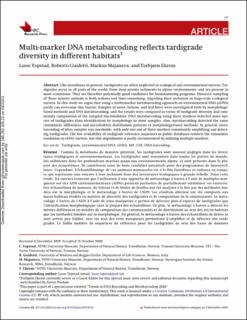| dc.contributor.author | Topstad, Lasse | |
| dc.contributor.author | Guidetti, Roberto | |
| dc.contributor.author | Majaneva, Markus | |
| dc.contributor.author | Ekrem, Torbjørn | |
| dc.date.accessioned | 2021-03-23T08:37:10Z | |
| dc.date.available | 2021-03-23T08:37:10Z | |
| dc.date.created | 2021-02-23T20:37:11Z | |
| dc.date.issued | 2021 | |
| dc.identifier.citation | Genome. 2021, 64 (3), 217-231. | en_US |
| dc.identifier.issn | 0831-2796 | |
| dc.identifier.uri | https://hdl.handle.net/11250/2734966 | |
| dc.description.abstract | Like meiofauna in general, tardigrades are often neglected in ecological and environmental surveys. Tardigrades occur in all parts of the world, from deep marine sediments to alpine environments, and are present in most ecosystems. They are therefore potentially good candidates for biomonitoring programs. However, sampling of these minute animals is both tedious and time-consuming, impeding their inclusion in large-scale ecological surveys. In this study we argue that using a multi-marker metabarcoding approach on environmental DNA (eDNA) partly can overcome this barrier. Samples of moss, lichens, and leaf litter were investigated both by morphology-based methods and DNA metabarcoding, and the results were compared in terms of tardigrade diversity and community composition of the sampled microhabitats. DNA metabarcoding using three markers detected more species of tardigrades than identification by morphology in most samples. Also, metabarcoding detected the same community differences and microhabitat distribution patterns as morphology-based methods. In general, metabarcoding of litter samples was unreliable, with only one out of three markers consistently amplifying and detecting tardigrades. The low availability of tardigrade reference sequences in public databases restricts the taxonomic resolution in eDNA surveys, but this impediment is partly circumvented by utilizing multiple markers. | en_US |
| dc.language.iso | eng | en_US |
| dc.publisher | Canadian Science Publishing | en_US |
| dc.rights | Navngivelse 4.0 Internasjonal | * |
| dc.rights.uri | http://creativecommons.org/licenses/by/4.0/deed.no | * |
| dc.title | Multi-marker DNA metabarcoding reflects tardigrade diversity in different habitats | en_US |
| dc.type | Peer reviewed | en_US |
| dc.type | Journal article | en_US |
| dc.description.version | publishedVersion | en_US |
| dc.source.pagenumber | 217-231 | en_US |
| dc.source.volume | 64 | en_US |
| dc.source.journal | Genome | en_US |
| dc.source.issue | 3 | en_US |
| dc.identifier.doi | 10.1139/gen-2019-0218 | |
| dc.identifier.cristin | 1892953 | |
| dc.relation.project | Norges forskningsråd: 226134 | en_US |
| dc.relation.project | Artsdatabanken: 33-16 | en_US |
| dc.description.localcode | Copyright remains with the author(s) or their institution(s). This work is licensed under a Creative Commons Attribution 4.0 International License (CC BY 4.0), which permits unrestricted use, distribution, and reproduction in any medium, provided the original author(s) and source are credited. | en_US |
| cristin.ispublished | true | |
| cristin.fulltext | original | |
| cristin.qualitycode | 1 | |

